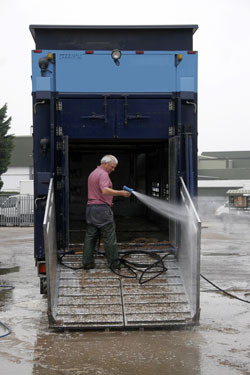



Help Keep on Top of Cleaning, Disinfection
UK - BPEX is offering help for pig producers with their cleaning and disinfection (C&D) – made harder now as temperatures rise above zero, thaw sets in and units become muddier.

BPEX’s Veterinary Projects Manager Helen Clarke explains that a consistently high standard of C&D is an effective way to break the on-farm cycle of reinfection with infectious diseases like swine dysentery or salmonella. "A C&D plan should form a major part of a farm’s veterinary health plan," says Ms Clarke. "Although producers know that buildings can become ‘pig sick’ and continued use can bring about a steady decline in health and performance, the reality is that keeping on top of C&D can be challenging."
To help producers formulate the best C&D routine possible, BPEX provides a free cleaning and disinfection DVD and advice sheet offering advice on the range of disinfectants available and their effectiveness against different organisms. This practical DVD guides producers through the most effective process for clearing dirt and grime from all areas of the unit. It also provides information on the most appropriate disinfectants to use in certain conditions.
Ms Clarke states that this time of year is ‘prime time’ for infection. "Swine dysentery can survive for around 10 days in faeces during the summer but, with temperatures in late winter averaging between 5-10°C, the organism’s survival capacity increases to a massive 50 days."
She says that, in these conditions, it’s important to use the appropriate concentration of disinfectant for both the temperature and specific pathogen, as recommended by the manufacturer. "Producers should also ensure that pen surfaces are as dry as possible before introducing pigs – in dry conditions, the infectious organism will die out in three days."
Ms Clarke concludes by reminding producers that these points also apply to equipment, clothing and visitors. "Lorries, in particular, must be thoroughly cleaned and disinfected by the haulier before travelling to your unit."
Further ReadingFind out more information on swine dysentery by clicking here. |








